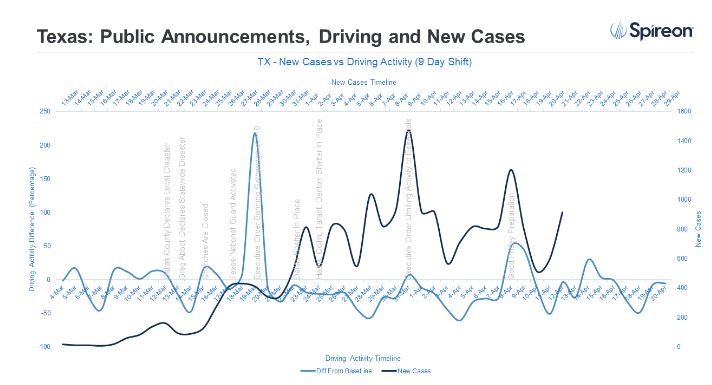Spireon Driving Data Shows Relationship Between Mobility and Upsurge in COVID-19 Cases

8 Billion Data Points from More Than 3 Million Vehicles Analyzed, Revealing Correlation
Spireon, the vehicle intelligence company, revealed an analysis of proprietary consumer driving data that signals a distinct relationship between increased driving that has occurred following stay-at-home orders and increase in COVID-19 cases both at the state and national level. Specifically, Spireon data show that 10-14 days after recent spikes in driving activity, there have been corresponding upticks in the number of reported cases of COVID-19. This timeframe mirrors the incubation period of the virus, with the data serving as another indication that surges in public mobility can lead to an escalation of viral infections.
“As the coronavirus pandemic is sweeping across the nation, claiming the lives of thousands of Americans and causing disruption across industries, analysis of Spireon data shows clearly that having more vehicles on the road has negative implication for the spread of the virus,” stressed Spireon CEO Kevin Weiss. “The correlation between more driving activity and new cases of the virus further substantiates the importance of social distancing. We want these findings to serve as an important public service announcement as we all strategize ways to reopen the economy safely.”
Spireon gathered and analyzed eight billion data points nationwide, studying the driving activity of over three million vehicles starting March 1, to understand the relationship between spikes in driving and growth in the number of COVID-19 cases. Driving activity was measured against baseline reflecting average driving activity before COVID-19.
At the state level, an analysis of 1.1 million vehicles and 2.5 billion data points shows a significant increase in driving occurred immediately following the shelter-in-place orders in states like California and Texas. Subsequently, approximately 10-14 days after the surge in driving, the number of reported COVID-19 cases also rose. The 10-14 day delay in infections matches the duration of the COVID-19 incubation period, as outlined by the World Health Organization. In Florida and Louisiana, spikes in driving during spring break yielded the same result. Nationwide, driving data reveal a significant uptick in driving over Easter weekend, from Friday, April 10 to Sunday, April 12, which is already beginning to reflect an increase of COVID-19 infections this week.
“As the largest aftermarket telematics supplier in the country, Spireon’s data analysis team has unique visibility to a large volume of commercial and consumer driving data,” said Prem Hareesh, senior vice president of software engineering at Spireon. “As COVID-19 has rapidly transformed American life, our team continues to analyze how state and federal order, major holidays and more are causing spikes in driving that leads to increase in viral infections.”
Spireon data also shows that reported COVID-19 cases notably dropped following a 40-50% downturn in driving activity at both the state and national level in late March. These findings support public health guidelines enforced during the pandemic and illustrate the strong causal relationship between mobility and increased infections.
Category: Connected Fleet News, Driver Stuff, Featured, Fleet Diagnostics & Software, Fleet Tracking, General Update, News










